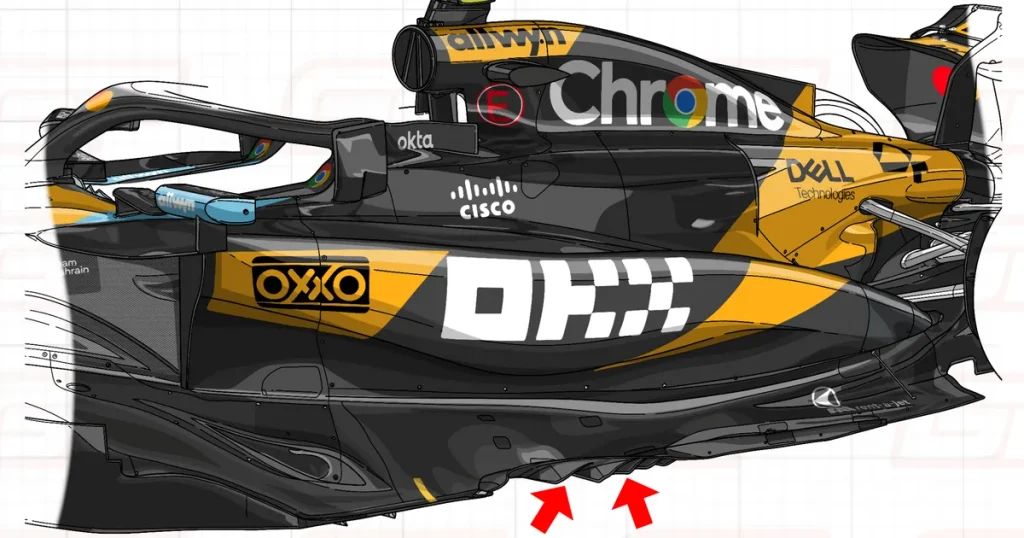The Bahrain Grand Prix showcased McLaren‘s significant potential on a track that was demanding on tires. Throughout qualifying, Piastri managed to secure pole position and subsequently controlled the race on Sunday, demonstrating superior tire management compared to his rivals. The MCL39 appeared to excel across various conditions, particularly under warmer temperatures. Let’s delve into the reasons behind this performance.
McLaren’s Soft Mechanical Setup
Throughout the weekend, McLaren clearly had the fastest car, although their advantage fluctuated depending on track conditions and temperature. Under hot asphalt, the MCL39 was notably quicker, outpacing Leclerc by approximately 0.8 seconds in FP3, and was the only car capable of making the soft tires last for the entire lap without overheating in the final sector. In contrast, other teams faced severe overheating, particularly in the rear tires during the early part of the lap, hampering their ability to maintain control through the final corners.
The McLaren edge diminished during the night sessions; as temperatures dropped around 10°C, the grip on the tarmac improved, allowing rival teams to make effective use of the soft tires during qualifying and the race without issues.
Despite changes in track conditions and temperature during qualifying and the race, McLaren consistently performed as the fastest team, particularly regarding race pace configuration. Their advantage stemmed from two closely related setup choices:
- The first was adopting a softer suspension setup;
- The second was opting for a higher downforce configuration.
Regarding the first choice, McLaren has made significant progress in understanding and optimizing the interaction between tires and asphalt. Mechanics typically make their decisions to enhance the car’s grip, which relies on the friction between tires and the track surface. A critical parameter determining the roughness of the asphalt is called “micro,” which influences the surface temperature of the tire and affects grip due to heat generation.
Benefits of a Higher Downforce Setup for Tire Management
The second setup decision made by McLaren’s engineers involved adopting a higher level of downforce compared to competitors during the Bahrain race. This additional downforce, primarily generated by the car’s bodywork and Venturi channels, provided a considerable advantage in tire management throughout the race. The MCL39 effectively maintained its tires within the optimal operating window, allowing Piastri to complete 14 laps on the soft tires during the initial stint while maintaining a faster pace than those on mediums behind him.
Despite the substantial benefits of higher downforce configurations, the McLaren was the slowest in top-speed traps throughout the weekend. The team utilized a medium-high downforce rear wing and a single-element beam wing, which helped to minimize rear tire wear by reducing sliding out of slower corners. However, this strategy proved challenging for Norris, who struggled to overtake Leclerc and was unable to pass Russell due to a lack of top speed.
These two setup choices provided McLaren with a considerable advantage during the latter stages of the race on medium tires. With a lighter fuel load, the MCL39 could handle the track aggressively and navigate medium- and slow-speed corners effectively, as evidenced by both Norris and Piastri gaining significant time on their rivals across the middle sector of the race, especially as tire wear became more apparent.
The upcoming race in Jeddah presents a different challenge for McLaren, given the circuit’s emphasis on straights and high-speed corners, with only the latter suiting their car’s strengths. The smooth surface there will likely result in minimal tire wear, as seen in Suzuka, potentially undermining McLaren’s advantage. Moreover, it will be the first race where low downforce setups will be necessary for all cars, highlighting the contrasts faced compared to the medium-downforce adaptations used so far.
In summary, McLaren’s commanding performance at the Bahrain GP was bolstered by favorable conditions and an optimal setup. Observing how the situation develops in the next race will be intriguing; should McLaren dominate again, it could further complicate matters for their competitors.



